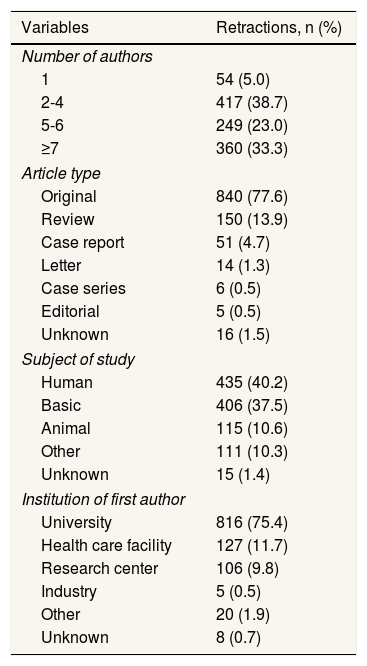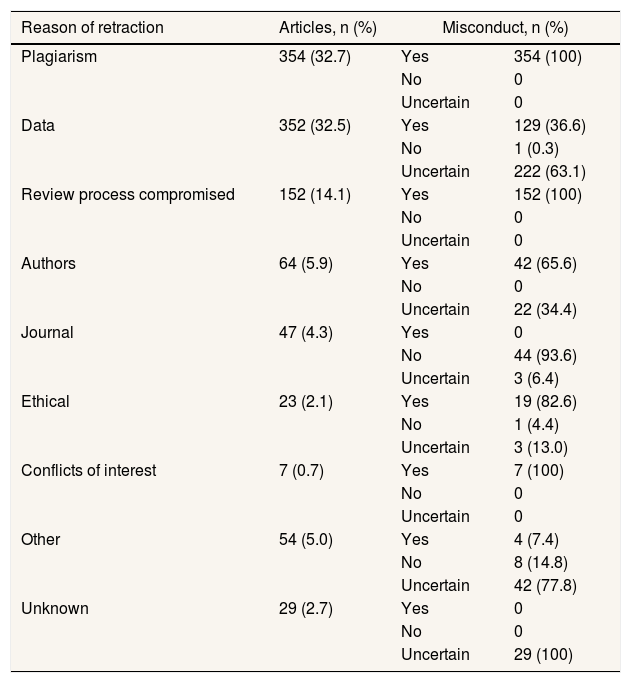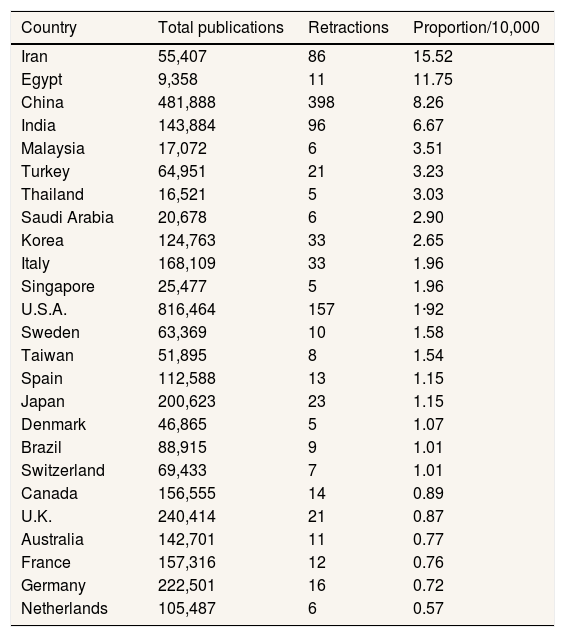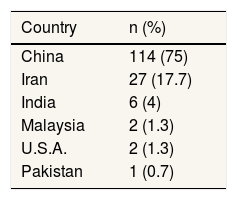To analyze the causes of retracted publications and the main characteristics of their authors.
MethodA descriptive cross-sectional study was designed including all retracted publications from January 1st, 2013-December 31st, 2016 indexed in PubMed. The causes of retraction were classified as: data management, authorship issues, plagiarism, unethical research, journal issues, review process, conflict of interest, other causes, and unknown reasons. Then, misbehaviour was classified as misconduct, suspicion of misconduct or no misconduct suspicion.
Results1,082 retracted publications were identified. The retraction rate for the period was 2.5 per 10,000 publications. The main cause of retraction was misconduct (65.3%), and the leading reasons were plagiarism, data management and compromise of the review process. The highest proportion of retracted publications corresponded to Iran (15.52 per 10,000), followed by Egypt and China (11.75 and 8.26 per 10,000).
ConclusionsCurrently, misconduct is the main cause of retraction. Specific strategies to limit this phenomenon must be implemented. It would be useful to standardize reasons and procedures for retraction. The development of a standard retraction form to be permanently indexed in a database might be relevant.
Analizar las causas de las retractaciones y las características fundamentales de sus autores.
MétodoSe diseñó un estudio descriptivo, transversal, que incluyó todas las publicaciones con retractación entre el 1 de enero de 2013 y el 31 de diciembre de 2016 indexadas en PubMed. Las causas de la retractación fueron clasificadas como manejo de datos, asuntos de autoría, plagio, investigación no ética, asuntos de las revistas, proceso de revisión, conflictos de intereses, otras causas y razones desconocidas. Tras esto, la conducta indebida fue clasificada como mala conducta, sospecha de mala conducta y sin sospecha de mala conducta.
ResultadosSe identificaron 1.082 publicaciones retractadas. La proporción de publicaciones retractadas fue de 2,5 por cada 10.000 publicaciones para el periodo evaluado. La principal causa de retractación fue la mala conducta (65,3%), y las causas principales fueron plagio, manejo de los datos y compromiso del proceso de revisión. La mayor proporción de publicaciones retractadas correspondió a Irán (15,52 por 10.000), seguido de Egipto y China (11,75 y 8,26 por 10.000, respectivamente).
ConclusionesActualmente, la mala conducta es la principal causa de retractación. Deberían implementarse estrategias específicas para limitar este fenómeno. Sería de utilidad uniformar los motivos y procedimientos para la retractación. Podría ser apropiado el desarrollo de un formulario estándar de retractación que sea indexado permanentemente en una base de datos.
The number of retracted papers in last years is growing.1 This phenomenon is probably linked to the increase in the number of published papers and scientific journals, but also to the improvement in methodologies to detect fraud or misconduct, such as software to detect plagiarism, mandatory registry of clinical trials, required declaration of conflict of interest and so on.2
The reasons for retracting a publication are diverse, changing from an unintentional editorial mistake to an intentional fraud (i.e. data or image manipulation, fabricated conclusions or duplication of publications).3,4 Hence, two independent retraction categories might be differentiated; a first one based on mistakes and the second based on intentional misconduct.5,6 Whatever the reason, retraction represents a threat to the integrity of the scientific progress, by breaking the confidence on scientific community, leading to wrong or uncertain decisions and because of the risk of conducting future studies based on inaccurate conclusions. Loss of researchers’ credibility is also attributable to misconduct. Furthermore, duplicated publications would interfere on meta-analytic technics, usually leading to an overestimation of the studied effect and inflated CVs of those using this practice.7,8
The issue of misconduct and its characteristics has been focused under diverse approaches, and different frequencies for the main causes of retractions have been observed.1,5 New categories of misconduct have also been reported recently.9 There is a need for a better understanding and sorting of the multiple and current causes of retraction before attempting to set up editorial measures. Also, misconduct characteristics from authors in emerging countries need to be elucidated, and an updated, homogeneous and rigorous classification of the retraction papers is needed.10
A deeper knowledge on the causes of retraction is therefore critical to raise awareness of Editors and readers of scientific journals as a first step before establishing measures to limit this phenomenon. Thus, we aimed to describe retracted publications and their main characteristics (including some related to authors) in journals indexed in PubMed.
MethodsA descriptive cross-sectional study was conducted through a PubMed search from January 1st, 2013 to December 31st, 2016 searching for articles indexed as “retracted publication”. The last access to the database was April 30th, 2017.
Search strategyThe search strategy was the following (“retracted publication”[Publication Type] OR “retracted publication”[All Fields]) AND (“2013/01/01”[PDAT]: “2016/12/31”[PDAT]). Conference abstract publications were not included because the nature of the publication was completely different from the reported and included papers. Access to abstract or full article was not required to be included.
Data extractionThe following information was obtained for each paper classified as retracted: total number of authors, institutions (classified as university, health care facility, research center, industry, and other), publication type (classified as original report, review, case report, case series, letter, or editorial), subject of study (catalogued as human, animal, basic or other), country of origin of first author and original language.
Definition of cause of retractionRetracted publications were classified based on retraction notice narrative and on the categories proposed by the Committee of Publishing Ethics (COPE) definitions and previous classifications.3,4 Nine main categories were finally considered which are classified as follows:
- 1)
Data. Based on data management by authors. On the grounds that the findings are unreliable, either as a result of an honest error (scientific error, mistake on data processing or analysis) or as the result of an intentional manipulation, creation or fabrication of data or images.
- 2)
Authors. Including authorship dispute, non-informed authors involved, and fictitious authors.
- 3)
Plagiarism. Including self-plagiarism, redundant or duplicated publications. It also includes the use of material previously published by others without appropriate quoting or permission.
- 4)
Unethical research. Comprising no ethical approval, or lack of proper informed consent.
- 5)
Journal issues. Covering editorial duplication of contents or uploading an incorrect manuscript or version.
- 6)
Review process. Fake peer review reports or other issues related with the peer-review process.
- 7)
Conflict of interest. Undisclosed conflict of interest.
- 8)
Other. Including request by authors or editors for retraction if not described further.
- 9)
Unknown.
Among these categories, misbehavior was classified further as misconduct (fraud, as an opposite of honest error), suspicion of misconduct and no misconduct suspicion.
Data collection and classification was performed by ICV, and doubtful assignments were discussed with ARR.
Data analysisThe percentage of total retracted publications or retracted publications because of misconduct per 10,000 PubMed publications was calculated, dividing the total number of retracted publications or the number or retracted publications because of misconduct by the total number of publications in PubMed for the study period. Cumulative incidence rates were expressed as percentages. The same approach was used to calculate the proportion of retracted publications by author's country of origin; the denominator was calculated identifying publications per country and year using the field description [Affiliation]. STATA/SE® v13 (College Station, Texas) was used for all statistical analyses.
ResultsThe number of records identified through the database searching was 1,091; nine of them were excluded as they belonged to conference abstract publications (Fig. 1). So, the total number of retracted publications for the study period was 1,082, while the number or published papers for the same period was 4,384,945. The retraction frequency for the period was 2.5 per 10,000 publications.
The main characteristics of retracted publications are described in Table 1. Retracted papers were mainly written by two to four authors (38.7%). Single author was only present in 5% of retractions. The distribution of misconduct by number of authors is described in Figure 2. Regarding the type of article, 840 (77.6%) were original papers, and 150 (13.9%) reviews, followed by 51 (4.7%) case reports. Among these retracted papers, the most frequent subjects of study were human and basic science with 435 (40.2%) and 406 (37.5%) retractions, respectively. Considering first author institution, the most frequent origin of papers was university, representing a 75.4% of retractions. Main language of retracted publications was English, and only eight papers were published in other languages
Characteristics of retracted publications (2013-2016; n = 1,082).
| Variables | Retractions, n (%) |
|---|---|
| Number of authors | |
| 1 | 54 (5.0) |
| 2-4 | 417 (38.7) |
| 5-6 | 249 (23.0) |
| ≥7 | 360 (33.3) |
| Article type | |
| Original | 840 (77.6) |
| Review | 150 (13.9) |
| Case report | 51 (4.7) |
| Letter | 14 (1.3) |
| Case series | 6 (0.5) |
| Editorial | 5 (0.5) |
| Unknown | 16 (1.5) |
| Subject of study | |
| Human | 435 (40.2) |
| Basic | 406 (37.5) |
| Animal | 115 (10.6) |
| Other | 111 (10.3) |
| Unknown | 15 (1.4) |
| Institution of first author | |
| University | 816 (75.4) |
| Health care facility | 127 (11.7) |
| Research center | 106 (9.8) |
| Industry | 5 (0.5) |
| Other | 20 (1.9) |
| Unknown | 8 (0.7) |
Reasons for retraction are shown in Table 2. Plagiarism and data processing related issues were the most common reasons for retraction of publications, with 354 (32.7%) and 352 (32.5%) manuscripts retracted, respectively. Significant differences appeared when analyzing the proportion of misconduct within categories, as misconduct represented a 100% in the case of plagiarism, and only a 36.6% were certainly retracted because of misconduct in the case of data process. Review process compromised represented the third group in order of frequency, comprising a 14% of the total of retracted publications, again with a 100% accounting for misconduct. Authors’ issues represented a 5.9% of the retracted papers.
Reasons for retraction and proportion of misconduct by category.
| Reason of retraction | Articles, n (%) | Misconduct, n (%) | |
|---|---|---|---|
| Plagiarism | 354 (32.7) | Yes | 354 (100) |
| No | 0 | ||
| Uncertain | 0 | ||
| Data | 352 (32.5) | Yes | 129 (36.6) |
| No | 1 (0.3) | ||
| Uncertain | 222 (63.1) | ||
| Review process compromised | 152 (14.1) | Yes | 152 (100) |
| No | 0 | ||
| Uncertain | 0 | ||
| Authors | 64 (5.9) | Yes | 42 (65.6) |
| No | 0 | ||
| Uncertain | 22 (34.4) | ||
| Journal | 47 (4.3) | Yes | 0 |
| No | 44 (93.6) | ||
| Uncertain | 3 (6.4) | ||
| Ethical | 23 (2.1) | Yes | 19 (82.6) |
| No | 1 (4.4) | ||
| Uncertain | 3 (13.0) | ||
| Conflicts of interest | 7 (0.7) | Yes | 7 (100) |
| No | 0 | ||
| Uncertain | 0 | ||
| Other | 54 (5.0) | Yes | 4 (7.4) |
| No | 8 (14.8) | ||
| Uncertain | 42 (77.8) | ||
| Unknown | 29 (2.7) | Yes | 0 |
| No | 0 | ||
| Uncertain | 29 (100) | ||
Of the 1,082 retracted publications, a total of 707 were classified as misconduct, representing a 65.3% of the total number of retractions, with a rate of 1.6 per 10,000 published papers. Misconduct proportion among retracted papers was 67.1%, 52.2%, 67.2% and 70% for 2013, 2014, 2015 and 2016, respectively.
Regarding country of origin, two countries had frequencies greater than 10 retracted papers by 10,000 published papers (1 per 1,000 published papers). The highest frequency of retracted publications corresponded to Iran, with 15.52 papers retracted per 10,000 papers published (Table 3). Egypt retracted 11.75 of every 10,000 papers published. China followed the list with a rate of retractions of 8.26. Peer review fraud was only related to six countries (Table 4) and was most frequent in China followed by Iran.
Proportion of retractions per country of origin (2013-2016).
| Country | Total publications | Retractions | Proportion/10,000 |
|---|---|---|---|
| Iran | 55,407 | 86 | 15.52 |
| Egypt | 9,358 | 11 | 11.75 |
| China | 481,888 | 398 | 8.26 |
| India | 143,884 | 96 | 6.67 |
| Malaysia | 17,072 | 6 | 3.51 |
| Turkey | 64,951 | 21 | 3.23 |
| Thailand | 16,521 | 5 | 3.03 |
| Saudi Arabia | 20,678 | 6 | 2.90 |
| Korea | 124,763 | 33 | 2.65 |
| Italy | 168,109 | 33 | 1.96 |
| Singapore | 25,477 | 5 | 1.96 |
| U.S.A. | 816,464 | 157 | 1·92 |
| Sweden | 63,369 | 10 | 1.58 |
| Taiwan | 51,895 | 8 | 1.54 |
| Spain | 112,588 | 13 | 1.15 |
| Japan | 200,623 | 23 | 1.15 |
| Denmark | 46,865 | 5 | 1.07 |
| Brazil | 88,915 | 9 | 1.01 |
| Switzerland | 69,433 | 7 | 1.01 |
| Canada | 156,555 | 14 | 0.89 |
| U.K. | 240,414 | 21 | 0.87 |
| Australia | 142,701 | 11 | 0.77 |
| France | 157,316 | 12 | 0.76 |
| Germany | 222,501 | 16 | 0.72 |
| Netherlands | 105,487 | 6 | 0.57 |
We have found that 2.5 per 10,000 published papers were retracted during the period 2013-2016. Of them, confirmed misconduct accounts for 65.3% of retracted publications. This study supports the idea that in late years the causes of retraction are moving from unintentional error to misconduct.1 These results have been achieved through a research including all causes of retraction, and not limited to a specific aspect.10–12 Furthermore, we have to consider that the intentional misconduct we have observed only underrepresents the real rate of intentional misconduct.13,14 It is not currently possible to assess the real rate of published research reflecting misconduct and this paper only shows those misconduct types that are detected more easily by scientific journals. Other questionable research practices are beyond the scope of the present research. Specific studies using anonymized surveys have observed that conducts such as the change of study design, methodology or results in response to pressure from a funding source, or even the fail to present data contradicting one's own previous research are misconduct practices that are relatively frequent, but impossible to asses under this focus.13,14
Retraction due to misconduct is probably the effect of an increasing pressure on authors to publish.15,16 This demand is patent in the case of peer review fraud, with authors directly providing fake reviewers to journal editors.9 Up to 14% of retractions might have been avoided with a more severe control over the review process, and not entrusting authors with the responsibility to provide reviewers and non-accredited email addresses. Editorial process has to be aware of this and other potentially new ways of defrauding, and learn, innovate and improve peer-review quality process over time.17 Meaningful proposals have been made to fight this rising pressure, in the line that scientific merits should not be evaluated in order of quantity, but of quality, it might be more valuable to ask a researcher to select his or her three most significant publications when evaluation needed, instead of asking to list as many publications as possible.18
Errors are less common than described years ago, and are essentially related to editorial or journal mistakes, such as papers published twice.5 These errors, despite undesirables, can be solved through increasing editorial process quality, and once identified do not cause damage to the scientific process.
It is of particular interest the fact that most authors causing misconduct come from a quite limited group of countries such as Iran, followed by Egypt and China. We do not have a definitive explanation for this finding, however there are some data suggesting that specific pressures for publishing in those countries might play a role.15 A possible explanation might also be less stringent control policies on the researchers’ publication track or a higher awareness of Editors due to other experiences with research coming from these countries in the past.19 A relationship between first authors affiliated with lower-income countries and publications retracted for plagiarism has been previously described.10 Other factor to be taken into account is the language, as there is also a higher rate of plagiarism when first authors do not have English as first language,10 suggesting a difficulty to use original wording. Our results about location of peer review fraud are consistent with a previous description,9 and highlights the association between pressure to publish and the development of new ways to achieve the demanded aim.
Regarding number of authors, in previous studies, single-author represented a 6.6% of the retracted publications,20 this figure is consistent with our results, suggesting that probably a single person has less tendency to commit misconduct, and probably there is less group pressure to meet targets. Otherwise, the highest proportion of errors among single author papers, suggests that errors might be higher when the control of errors falls to one person.
Original articles are the most retracted, probably related to the high number of this publication type or perhaps because it is the publication type which has more quality thresholds. This is usually the publication type where a peer-review policy is strictly enforced. However, a reliable analysis of the total number of original articles published through the study period was not feasible, as PubMed filters are not rigorous on classifying nature of papers.10
We have not been able to describe misconduct by gender because the author's name is frequently only specified by the family name and initial, this fact makes confusion likely to happen with authors from different cultures or countries. This is not possible even considering institutions to identify them, because authors can move or have more than one affiliation. Likely, co-authorship does not guarantee a comprehensive identification of authors. Others have attempted this description before, reporting that it was not exceptional for an author to have more than one paper retracted.20,21 Nevertheless, predominance for male gender has been reported, among 228 researchers identified, 65% were male, representing a 88% for faculty members.22 It might be possible to evaluate individual authors by reviewing the annual reports of the U.S. Office of Research Integrity (ORI).22,23 This is an exhaustive and detailed approach, but limited in terms of extent, as few of the papers identified in PubMed are detailed by ORI. This lack of reliability in identification of authors would be solved if, as desirable, ORCID identifiers became generalized. Other potential solution would be Medline including a description of the first author gender. This would facilitate not only misconduct analysis, but also other analyses related to publishing policies related to gender.
One restraint found was the limited access to some of the retracted papers, limiting the ability to track authors, institutions or funding.24 We firmly believe that retracted publications should not be removed, instead, they should be marked and clearly identified as retracted, but available to access. Remove traces only helps misconduct researchers to hide and difficult research in this field. Similarly, some retraction notes are clear and descriptive of the cause of retraction, but others do not provide information at all, or this is minimum, and do not allow to understand the cause of retraction.3 Also, despite PubMed is the main biomedical bibliographic database, is not the only one. Therefore, the external validity of the results might be limited. There are other limitations derived from the nature of the data, first that an exact search cannot be reproduced since PubMed retrospectively includes records, so there is an increment on the number of papers retracted, as can be checked in Medline using the corresponding MeSH term, and second, derived from the former, this fact precludes the calculation of incidence per year, as it was not calculated initially.
This PubMed based analysis provides the possibility, despite the lack of certain details, to evaluate the largest possible series of cases and to have a realistic and general view of the retraction process, and specifically the author's pattern involved in retraction in recent years. A further strength of this study is the classification used, based on identifying first the cause of retraction, followed by assigning the misconduct pattern. Additionally, Medline guarantees a good coverage of medical journals, as those not indexed have less possibilities to have retractions, as in general terms, they have less strict review procedures, editorial committees less professionals or with less scientific prestige.
We cannot study deeply misconduct causes or types using exclusively a PubMed search as we have done. We should highlight that any type of misconduct found by us, and overall percentage of misconduct is underestimated, and we do not know the real misconduct rate among published research.1,13,14 We cannot analyze typical causes of misconduct such as guest or ghost authorship, non-declaration of conflict of interests, selection of non-independent referees (friends, colleagues) and other misconduct causes, which would require an in-depth analysis. A different methodology based on surveys might help to approach scientific conduct, going beyond the identifiable misconduct of studies such as this one, but with rate of response and sincerity as the main limitation, specially from those misbehaving scientists.13,14
We also have to acknowledge a limited capacity to classify publications as misconduct or not, if not clearly detailed in the retraction note. This has formerly been a source or errors, as publications classified initially as honest errors,1 were later reclassified as misconduct or possible misconduct.25
In summary, retraction of scientific publications is a phenomenon mainly related to misconduct. Strategies to limit retraction of publications have to be displayed and directed to the different causes of retraction. Given the described geographic patterns, special awareness on manuscript from particular countries might be considered. It would be useful to standardize reasons and procedures for retraction, and we propose the development of a standard retraction form whose results should be indexed permanently in databases such as Medline.
The number or retracted publications is increasing. Reasons for retractions, retraction frequency by countries and characteristics of authors involved are not well known.
What does this study add to the literature?This paper provides a comprehensive analysis of retracted publications in medical journals and their authors. The current paper supports the concept that misconduct is the main reason for publications retraction.
Carlos Álvarez-Dardet.
Transparency declarationThe corresponding author on behalf of the other authors guarantee the accuracy, transparency and honesty of the data and information contained in the study, that no relevant information has been omitted and that all discrepancies between authors have been adequately resolved and described.
Authorship contributionsBoth authors contributed equally and fully in all aspects of this manuscript.
FundingNone.
Conflicts of interestNone.






















